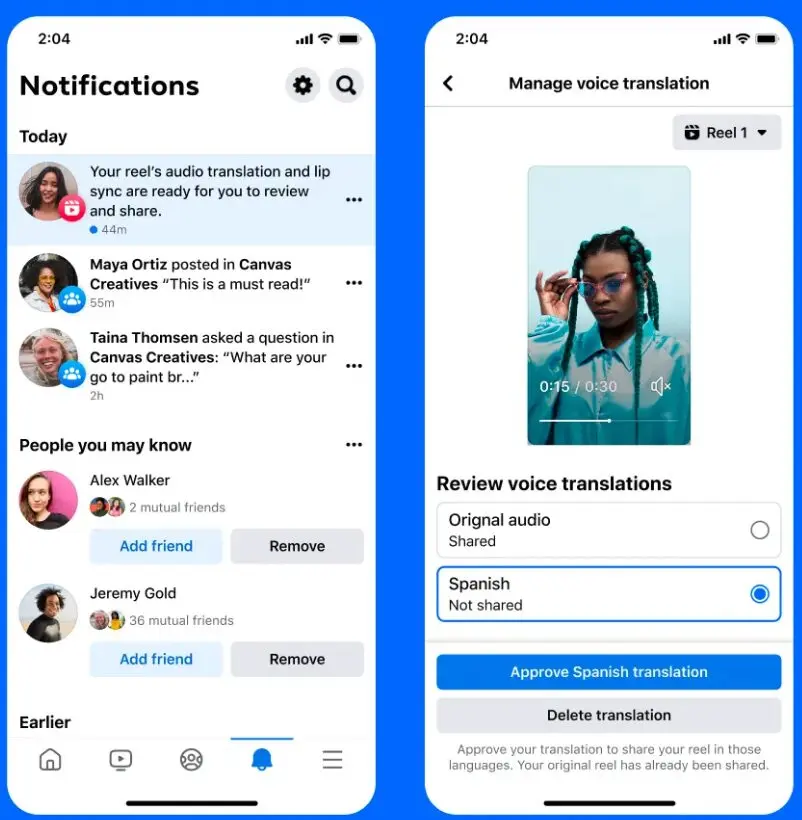- Meta’s AI dubbing tool translates creator voices while preserving tone and syncing lips, aiming for authenticity.
- The rollout starts with English ↔ Spanish but will expand to more languages, widening creator and brand reach.
- Creators can track viewership by language and even upload their own dubbed tracks for added flexibility.
- Marketers gain scalable opportunities to reach multilingual audiences, but translation quality and cultural nuance remain challenges.
A look at how Meta’s auto-translation feature could redefine cross-border reach on Facebook and Instagram.
Meta’s latest rollout signals a pivotal moment in the evolution of creator tools. With its new AI-powered dubbing and lip-syncing feature, the company is attempting to dissolve one of the most enduring barriers in digital media: language.
The tool allows creators to automatically dub their Reels into other languages while preserving their own voice tone and even aligning lip movements to match the translated audio. On paper, it looks like a solution that could unlock global audiences for creators, while simultaneously reinforcing Meta’s platform dominance at a time when TikTok and YouTube are battling for cultural relevance.
How the Tool Works
The AI translator operates directly within the Reels composer. Before publishing, creators can activate the “Translate your voice with Meta AI” toggle and decide whether to enable lip-syncing.

Source: Meta
Once switched on, the system dubs the video into the target language while maintaining the original voice’s cadence and inflection.
At launch, translations are limited to English ↔ Spanish, but Meta has confirmed expansion into additional languages in the future. The company highlights two core elements of the experience:
- Authenticity: Rather than a synthetic overlay, the translated voice mimics the creator’s natural tone.
- Visual Coherence: The lip-sync function ensures that dubbed speech visually matches the speaker’s mouth movements, increasing believability.
This combination positions the feature as more than a basic translation service; it attempts to preserve trust and continuity in the creator-viewer relationship.
Eligibility and Reach
The feature is rolling out globally in markets where Meta AI is available. On Facebook, creators need at least 1,000 followers, while all public Instagram accounts can access it immediately. Once enabled, translated content automatically surfaces in a viewer’s preferred language, and creators can track performance with a new analytics breakdown showing views by language.

Source: Meta
For those already dubbing manually, Meta also introduced the ability to upload up to 20 of their own translated audio tracks per Reel. This expands flexibility, especially for professional creators and brand teams managing multi-market campaigns.
Strategic Importance for Meta
The timing of this launch is deliberate. Meta is positioning itself as the first platform to natively integrate scalable, AI-powered dubbing at this level of polish. By doing so, it hopes to:
- Encourage creators to prioritize Facebook and Instagram when publishing multilingual content.
- Differentiate itself from TikTok, which is facing increased regulatory scrutiny and has yet to offer comparable tools.
- Provide brands and creators with more cost-efficient ways to expand audience reach without outsourcing translation or re-shooting content.
For Meta, this is not simply a feature add-on but part of its broader strategy to cement AI as a backbone of platform stickiness and creator loyalty.
Benefits and Limitations
The potential benefits are clear: creators can grow their audience across linguistic markets without altering their production workflows. Brands, in turn, gain scalable entry points into markets where subtitling alone has been insufficient for engagement.
However, limitations are equally important. The tool currently supports only two speakers. Accuracy may also be challenged by overlapping dialogue, background noise, or culturally nuanced expressions that machine translation cannot fully capture.
For creators aiming to foster long-term trust, ensuring translation quality will be essential.
Implications for Creators and Marketers
For marketers, the tool opens a new chapter in influencer partnerships. Campaigns can now extend to multilingual audiences with fewer barriers, lowering costs for transcreation and boosting potential ROI. For creators, it signals a shift toward “global-native” strategies where audience-building no longer needs to be confined by geography.
Yet this also raises competitive pressure. As language barriers shrink, creators from different markets may begin competing directly for the same audience attention. This dynamic could intensify the already crowded landscape of global content.
Toward a Multilingual Creator Economy
Meta’s AI dubbing tool is more than a convenience—it’s an infrastructural shift that could redefine how creators and brands think about scale. By making authentic multilingual content production accessible at the toggle of a button, Meta positions itself as the platform that accelerates the move toward a truly borderless creator economy.
The next test will be whether the technology can maintain translation accuracy as it expands into more languages and whether audiences will embrace AI-mediated authenticity as genuine connection.



